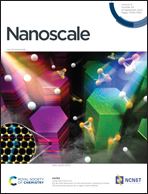An active carbon-nanotube polarizer-embedded electrode and liquid-crystal alignment†
Abstract
We report a method for constructing an active optical polarizer using an aligned carbon nanotube (CNT) sheet that is flexible, bendable, transparent, conductive, and also serves to anchor liquid-crystal (LC) molecules. A horizontally aligned CNT sheet was obtained by mechanical stretching from a vertically grown CNT forest, which was then transferred onto a substrate. A liquid polymer was infiltrated into the CNT sheet followed by UV curing, while a part of the CNT sheet was still exposed on the film surface without polymer coating. The polymer-embedded CNT sheet (P-ECS) film with 10 layers of CNT sheets exhibited a good polarization efficiency of 87%, a sheet resistance of 340 Ω □−1, and excellent ability to align LC molecules. The high stability of the P-ECS film was confirmed from the very low variation of sheet resistance (2%) and transmittance (10%) observed during a bending test of 1000 cycles. In addition, a twisted nematic LC device constructed using the P-ECS films shows a good bright–dark switching performance. The P-ECS film functions simultaneously as a transparent electrode, a film-type polarizer, and a LC alignment layer, demonstrating the multi-functionality of the active CNT film. This study thus highlights a wide range of possible applications for active polarizers and flexible displays.



 Please wait while we load your content...
Please wait while we load your content...